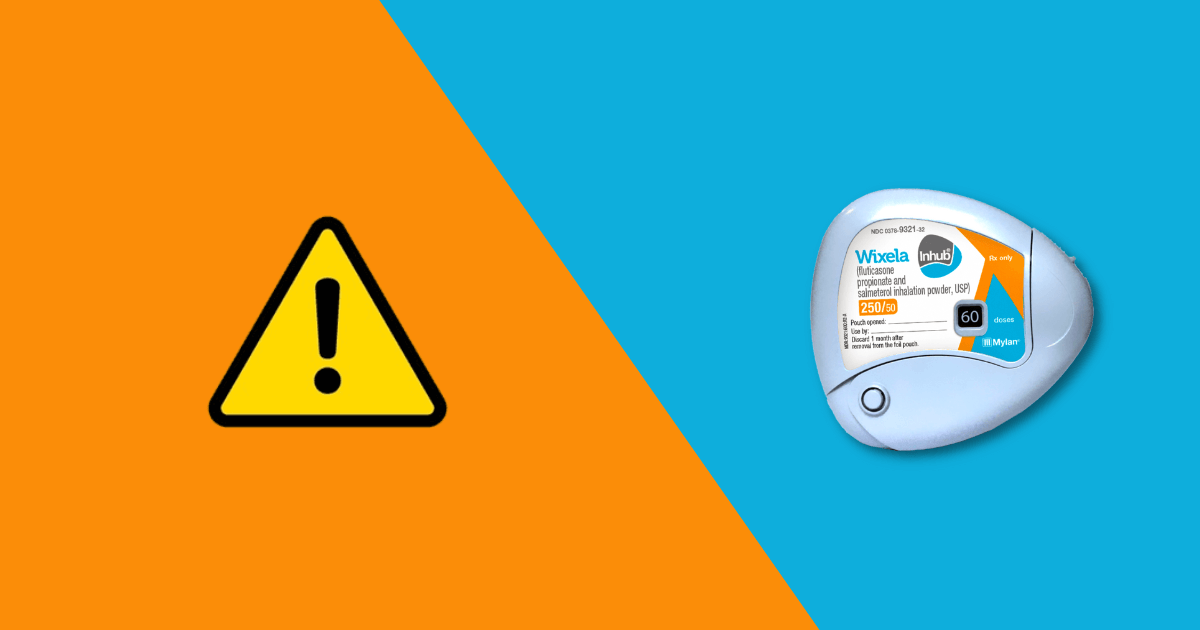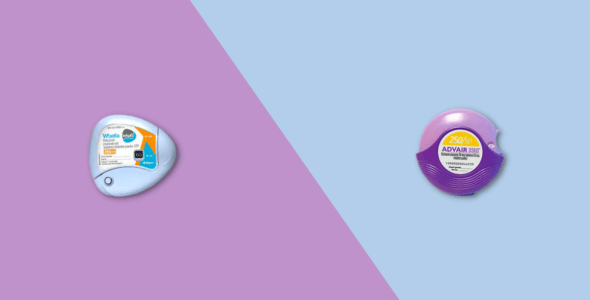Wixela side effects and how to avoid them
Table of contents
Wixela Inhub is an FDA (U.S. Food and Drug Administration) approved medication manufactured by Mylan Pharma. It contains two ingredients, fluticasone propionate an inhaled corticosteroid (ICS), and salmeterol xinafoate, a long-acting beta-agonist (LABA), also known as a bronchodilator. It is used to treat asthma and COPD. While Wixela is generally well tolerated, there are some potential side effects that people should be aware of. The most common side effects of Wixela include sore throats and thrush. Less common, but more serious side effects, can include high blood pressure and osteoporosis.
Learn more about the side effects of Wixela and what you can do to avoid them.
What is Wixela (fluticasone/salmeterol)?
Wixela Inhub is used:
- For the maintenance treatment of asthma and to prevent symptoms such as wheezing in patients 4 years of age and older
- To treat adults and children with asthma who are not well controlled with an asthma control medicine, such as an inhaled corticosteroid (ICS) and need both an ICS and a long-acting beta-2-adrenergic agonist (LABA) medicine
- For the maintenance treatment of chronic obstructive pulmonary disease (COPD), including chronic bronchitis, emphysema, or both
- To reduce exacerbations of COPD in patients with a history of exacerbations
Wixela Inhub does not work right away and should not be used to relieve intense flare-ups of shortness of breath, sudden asthma attacks, or bronchospasm. If an asthma attack occurs, use your quick-relief aerosol inhaler.
RELATED: What is Wixela Inhub
Wixela dosage
Wixela Inhub (fluticasone/salmeterol) is available as a dry powder inhaler (DPI) containing a combination of fluticasone propionate (100, 250, or 500 mcg) and salmeterol inhalation powder formulation for oral inhalation.
Wixela Inhub is used twice a day. The recommended starting dose is based on the severity of your asthma. You are advised to read the medication guide provided with this medicine for the drug information and patient information, and always speak with your healthcare provider for medical advice about any changes to your dose so they can monitor and evaluate your condition.
RELATED: Wixela Inhub Dosage
What are the side effects of Wixela?
The most common side effects of Wixela Inhub in clinical trials include:
- Headache
- Upset stomach, vomiting
- Sore throat, thrush (fungal infection of the throat)
- Signs of a common cold
More serious side effects of Wixela Inhub include:
- Worsening of existing infections
- Allergic reactions – hives, swollen, blistered, or peeling skin with or without fever, wheezing, tight chest or throat, problems breathing, swallowing, or talking, unusual hoarseness, swelling of the mouth, face, lips, tongue, or throat
- Upper respiratory tract infection, nasal sinus disorders
- High blood sugar – confusion, feeling sleepy, increased thirst, increased urination, fruity smell to the breath
- Signs of low potassium (hypokalemia) – muscle pain or weakness, muscle cramps, irregular heartbeat
- High blood pressure or low blood pressure
- Chest pain or pressure
- Feeling anxious
- Eye problems including glaucoma, cataracts, or other changes in vision
- Seizures
- Bone thinning or weakness (osteoporosis)
- Insomnia
- Tiredness
- Vaginal itching or discharge
- Weight gain
- Red or white patches in the mouth or throat
- Breathing problems – if you have trouble breathing, breathing that is worse, shortness of breath, wheezing or coughing after using Wixela Inhub use a rescue inhaler containing albuterol and get medical help right away
If you experience any of these serious side effects, stop taking Wixela and seek medical attention immediately. You are encouraged to report negative side effects of prescription drugs to the FDA. Visit www.fda.gov/medwatch, or call 1-800-FDA-1088.
Are there any long-term side effects of Wixela?
Long-term use of steroids may slow growth in children and young adults. You should use the lowest dose needed to manage your symptoms of asthma or COPD. Speak to your doctor for further medical advice.
Wixela drug interactions
Wixela can interact with other medications including:
- Other long-acting beta-2 agonists
- Antivirals – ritonavir, atazanavir, indinavir, saquinavir
- Antifungals – ketoconazole, itraconazole
- Antibiotics – clarithromycin, telithromycin
- Tricyclic antidepressants, and monoamine oxidase inhibitors (MAOIs)
- Beta-blockers
- Diuretics
Before taking Wixela, be sure to tell your doctor about all of the medications you are taking to ensure they are safe to take at the same time.
Wixela warnings & precautions
You should not use Wixela Inhub if you:
- Are allergic to the active ingredients fluticasone propionate or salmeterol xinafolate
- Have a known hypersensitivity to any of the other ingredients in Wixela Inhub
- Are pregnant or are planning to become pregnant
Talk to your doctor before using Wixela Inhub if you:
- Are taking any of the medications that could interact with Wixela Inhub
- Are breastfeeding or are planning to breastfeed
- Are using another drug similar to this one
- Have diabetes
- Have osteoporosis
- Have an allergy to milk proteins
- Have been in contact with anyone who has an infection such as chickenpox, measles, or flu
You should always check with your doctor or pharmacist before taking any medication, including Wixela, to make sure it is safe for you.
Who should not use Wixela?
Those with an allergy to the active and inactive ingredients, and anyone pregnant or planning to become pregnant should not use Wixela. Speak to your healthcare provider to discuss alternative treatments.
Can Wixela cause weight gain?
Yes, Wixela may cause some weight gain.
Does Wixela cause high blood pressure?
Wixela may increase your blood pressure. Monitor your blood pressure and speak to your doctor if your blood pressure is high.
Can Wixela be used long-term?
Salmeterol and fluticasone, the active ingredients in Wixela are designed to be used for long-term use. They are not to be used as rescue treatment. Discard your Wixela device safely if you have not used up all of your doses within one month of opening the foil package it is supplied in.
Does Wixela cause nausea?
Nausea is a common side effect of Wixela. Other common side effects include upper respiratory tract infection, bronchitis, thrush, throat irritation, coughing, changes in your voice, and hoarseness.
How long does it take for Wixela to work?
The effects of Wixela may take 1 week or more to be seen before you experience the maximum benefits of this treatment. Speak to your healthcare provider if your symptoms of asthma or COPD do not improve or get worse.
How to avoid Wixela side effects
The best way to avoid side effects is to take Wixela as directed by your doctor. Follow your doctor’s instructions carefully and do not take more or less than prescribed.
If you experience any side effects, talk to your doctor or pharmacist. They may be able to recommend ways to help reduce or prevent some of the side effects.
1. Stick to the recommended dosage
Take your prescribed dose of Wixela that has been recommended by your healthcare professional. Do not take more or less than prescribed.
2. Monitor your blood sugar levels
If you have diabetes, it is important to monitor your blood sugar levels closely while taking Wixela. Check your blood sugar levels as directed by your doctor and report any changes to your doctor immediately.
3. Drink plenty of fluids
Drink eight to 10 glasses of water or fluids every day to help prevent dehydration, which can make side effects worse.
4. Avoid alcohol
Alcohol is not known to interact with the ingredients in Wixela. You are advised however to limit your alcohol consumption as it can increase your risk of side effects. Also, avoid smoking as this will make your symptoms of asthma or COPD worse.
5. Don’t skip meals
Eating regular meals and snacks will help to prevent low blood sugar levels (hypoglycemia).
6. Check your feet
If you have diabetes, check your feet for any cuts, sores, or redness regularly. Tell your doctor if you experience any problems with your feet while taking Wixela.
7. Know the signs and symptoms of Wixela side effects
Signs and symptoms of side effects include sore throats, coughing, and thrush. If you experience any of these symptoms speak to your doctor for medical advice.
8. Monitor your weight
Wixela may cause weight gain. If you experience this side effect while taking Wixela, get medical advice from your doctor.
9. Tell your doctor about all medications you’re taking
Be sure to tell your doctor about all other medications you’re taking, including over-the-counter drugs, vitamins, and herbal supplements, as they can interact with Wixela.
10. Get regular medical check ups
It is important to get regular medical check ups and monitor your medical conditions. Your doctor will monitor your side effects and may adjust your dose of Wixela as needed.


